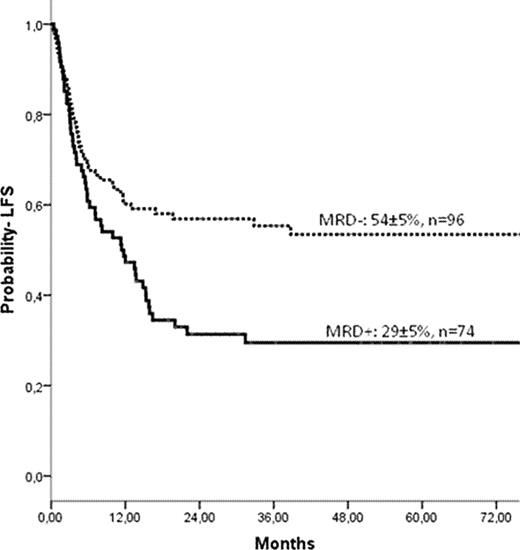Abstract
Abstract 532
Intensive and risk-adapted chemotherapy protocols may cure more than 80% of children with acute lymphoblastic leukemia (ALL). The detection of a positive minimal residual disease (MRD) in childhood ALL, is an independent prognostic factor of poor outcomes after chemotherapy treatment and has been used recently as a tool for risk stratification in most ALL treatment protocols. Its value before allogeneic related or unrelated hematopoietic stem cell transplantation (HSCT) has been described in small series of patients and it has been associated with outcomes. With the aim to investigate the prognostic significance of MRD before unrelated cord blood transplantation (UCBT) for ALL, we retrospectively analyzed children reported to the Eurocord registry. From 2000 to 2009, 316 children and adolescents with ALL in remission underwent a first single UCBT after a myeloablative conditioning regimen in 38 EBMT centers. Among these patients, 170 had an assessment of MRD before UCBT and were considered in this analysis. Of those, 72 patients underwent UCBT in first complete remission (CR), 77 in CR2 and 21 in CR3. The MRD assay was based on PCR (71%) or multiparameter flow cytometric analysis (FC) (29%). A positive MRD was defined according to treatment protocols of the various participating centers. MRD test before UCBT was positive (MRD+) in 74 patients (44%) and negative (MRD-) in 96 (56%). MRD was positive in 32 out of 72 patients in CR1, 31 out of 77 patients in CR2 and 11 out of 21 patients in CR3. The median interval from the last MRD test to UCBT was 18 days (12-42 days). The median follow-up was 46 months (4-104 months) and the median age at UCBT was 6.5 years (0.6-17 years). The most common immunephenotype was B-cell precursor ALL (83%). Of 72 patients transplanted in CR1, 56% had poor risk cytogenetics (t4;11 or t9;22). For patients in CR2 and CR3, the median interval between remission to relapse was 22 months (3-130 months). All patients received a TBI-based (63%) or Busulfan-based (37%), myeloablative conditioning regimen. GVHD prophylaxis consisted of cyclosporin (CSA) ± steroids in 75%. Sixty percent of cord blood units had 0–1 HLA mismatches with recipients and 40% had 2–3 mismatches (antigen level for HLA-A and B, allelic level for DRB1). Median infused TNC cell dose was 4.8 ×107/kg (1.30-18×107/kg) and median CD34+ was 1.8× 105/kg (1-10×105/kg). Cumulative incidence (CI) of day-60 neutrophil recovery (>500 mm3) and grade II-IV acute GVHD were 85±3% and 26±4%, respectively. Fifty-eight patients developed acute GVHD (grade 2, n=39, grade 3, n=14, grade 4, n= 5). The overall incidence of cGVHD was 17% at 4 years. Twenty-four patients had chronic GVHD (limited involvement, n=15, extensive disease, n=9). Overall CI of non-relapse mortality (NRM), relapse incidence (RI) and probability of leukemia free survival (LFS) at 4 years were 22±3%, 30±3%, and 44±4, respectively. In a univariate analysis, CI of NRM, RI and LFS at 4 years were 26±5%, 39±6%, and 29±5% in children with MRD+ and 20±4%, 24±3% and 54±5% in children with MRD- (p=0.08, p=0.05, p=0.006) respectively. In a multivariate analysis adjusted, a positive MRD before UCBT was an independent factor statistically associated with higher RI and decreased LFS (RI, HR=2.15, p=0.01, LFS, HR=1.97, p=0.003) (Figure 1). Also patients transplanted in more advanced status of disease at UCBT had higher RI and decreased LFS (RI, HR=4.25, p=0.002, LFS, HR=3.7, p=<0.0001); in fact, 4 years LFS was 56±6% for patients in CR1, 44±5% for patients in CR2 and 14±7% for patients in CR3 (p=<0.0001). Eighty-one patients died, causes of death were infections or other transplantation related events (n= 47) and disease progression (n= 34). The assessment of MRD in childhood ALL, is a powerful tool for predicting post transplant outcomes after UCBT. Approaches that can decrease relapse incidence in children with a positive MRD, such as better disease control before UCBT, rapid withdrawal of immunossupression, cell based immunotherapy or use of double cord blood transplantation, should be further investigated in order to improve final outcomes.
No relevant conflicts of interest to declare.

This icon denotes an abstract that is clinically relevant.
Author notes
Asterisk with author names denotes non-ASH members.


This feature is available to Subscribers Only
Sign In or Create an Account Close Modal